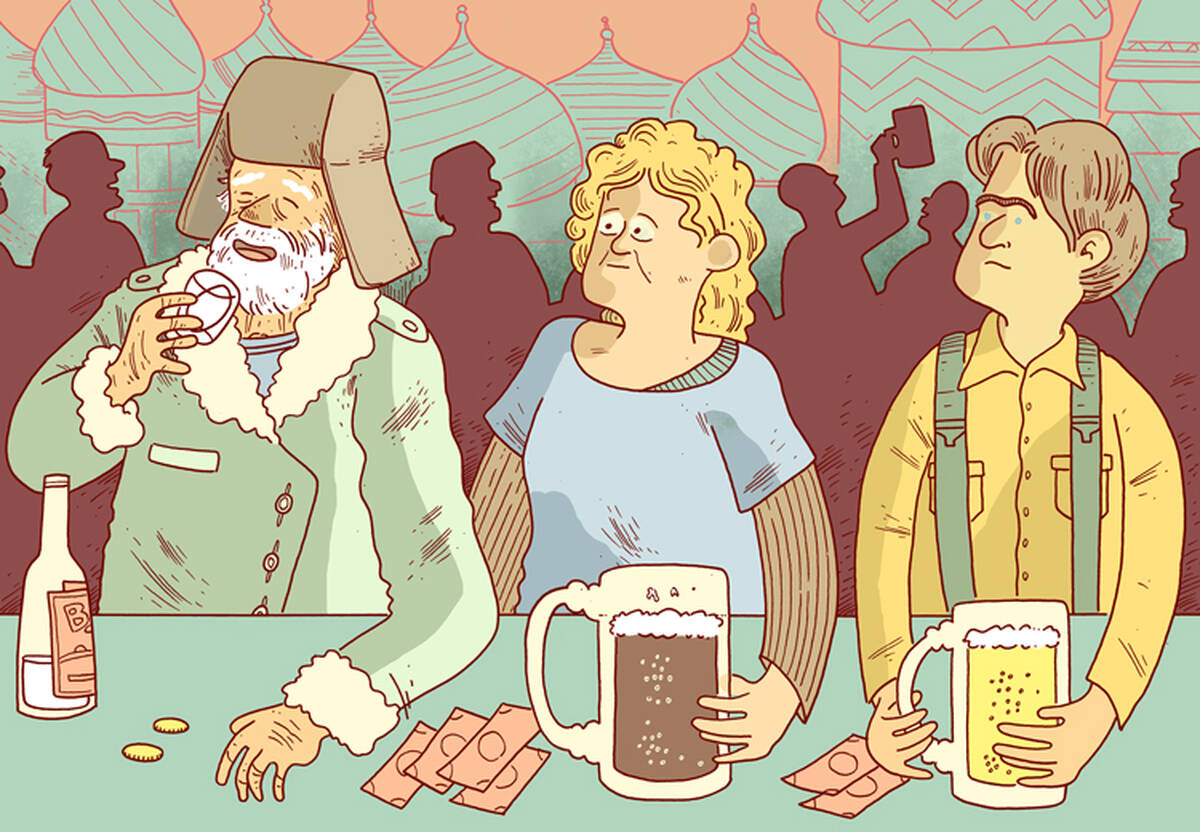Policy Finance & Accounting Dec 2, 2016
How Drinking Beer Is Saving Russian Lives
Decades later, a Soviet public health initiative is still increasing male life expectancy.

Will Dinski
Alcohol, a large part of Russian cultural life, is a highly toxic one, too.
Not only does alcohol lead Russian men to die on average 12 years earlier than American men; it also causes them to die sooner than their counterparts in highly impoverished nations such as Bangladesh and North Korea (by five years and two years, respectively). In fact, the World Health Organization has found that every fifth death among Russian men is due to alcohol abuse. This can come in many forms, such as alcohol poisoning, drunk-driving accidents, or a booze-fueled homicide.
But some Russian men appear to be escaping the worst of these effects, thanks to a short-lived government restriction on alcohol that ended 25 years ago.
How could a brief and long-defunct intervention be affecting public health today? That is the question at the core of recent research from Lorenz Kueng, an assistant professor of finance at the Kellogg School.
To find the answer, he investigated Soviet-era alcohol policy, historic patterns in Russian moonshine consumption, and present-day alcohol preferences.
“Public policies aimed at young consumers can affect them both in the short- and long-term by changing their consumption preferences.”
Kueng, who teamed up with Evgeny Yakovlev of Russia’s New Economic School, found that the decades-old government restrictions inadvertently taught some consumers to permanently prefer light alcohol over hard alcohol. This change, along with subsequent changes in the alcohol market following the collapse of the Soviet Union, increased male life expectancy today and is projected to continue to do so in the future.
A Brief Anti-Alcohol Policy
The story begins in 1985.
At that point, “it was obvious that low male life expectancy was a big problem for the Soviet economy,” Kueng says.
In response, Mikhail Gorbachev raised the prices of vodka, beer, and wine. He also increased penalties for public drunkenness, prohibited restaurants from selling alcohol before 2 p.m., and implemented many other measures designed to fight rampant alcoholism.
“It was a planned economy that was extremely effective,” says Kueng. Indeed, beer sales dropped by 29 percent, wine sales dropped by 63 percent, and vodka sales dropped by 60 percent.
However, just as in the United States during Prohibition, the production of illegal alcohol increased dramatically after the restrictions went into place. In Russia, that illegal alcohol took the form of samogon, a hard, moonshine-like liquor that could be made only in rural areas—“because you need a fairly large amount of space [to make it], and because it creates a smell that’s easily detectable,” Kueng explains. “So samogon was much more widely drunk in rural areas.”
Meanwhile, without much access to samogon, many urban consumers who had drunk vodka before the restrictions now turned to beer. That’s because under the restrictions, the price of vodka shot up higher than did the price of beer.
Even after taking the effect of samogon into account, the anti-alcohol campaign was estimated to have cut total alcohol consumption in Russia by about a third—but only while the restrictions lasted. Upon the collapse of the Soviet Union in 1991, the campaign collapsed too, and alcohol became widely available again. Not only that, but soon after the collapse, the beer industry expanded rapidly, exposing consumers to many more types of beer than had been available under the Soviet regime.
Changes in Alcohol Consumption
Kueng and Yakovlev wondered how the anti-alcohol campaign and subsequent beer-market expansion might have affected the drinking preferences of adults who reached drinking age during that time. To find out, they turned to the Russia Longitudinal Monitoring Survey, a series of surveys designed to monitor the effects of Russian reforms on the health and economic welfare of households and individuals.
As the data revealed, consumers who were roughly 16–22 years old and living in urban areas during the anti-alcohol campaign prefer—to this day—light alcohol such as beer. So do the consumers who were that age during the beer market’s rapid expansion after the collapse of the Soviet Union.
Meanwhile, consumers who were 16–22 and who lived in rural areas during the anti-alcohol campaign—that is, those who were likelier to have access to samogon—still prefer hard alcohol such as vodka.
How consistent have those preferences been across time? Kueng puts it this way: “If I know your consumption preferences at age 22, I can predict your consumption preferences about 20 years later.”
Those findings become additionally important when coupled with data on recent trends in Russian male life expectancy.
As low as those expectancies are, they have actually improved quite a bit in recent years: since the early 2000s, when the impact of the Soviet restrictions would have started to be seen on male mortality rates, that rate has fallen by about a third.
And by comparing mortality rates between those who continued drinking the same amount of pure alcohol in the form of hard alcohol and those who switched to consuming this amount in the form of light alcohol, Kueng and Yakovlev are able to attribute a full 60 percent of this effect to changes in alcohol preferences caused by Gorbachev’s anti-alcohol campaign and the subsequent expansion in the beer market decades earlier. This is because a person is much more likely to binge drink—and thus die from alcohol poisoning or an alcohol-related accident—with vodka than with beer. Another 15 percent of the decrease, they say, is due to the decrease in the level of pure alcohol consumed.
They estimate that the same factors will cause Russian male mortality to decrease by another 25 percent over the next 20 years.
“The increase in life expectancy will happen simply because new generations will be more accustomed to light alcohol and will replace older generations who had strong preferences for hard liquor,” they write.
Short-Term Changes, Long-Term Results
That is all great news for Russian men (and those who love them). But how might Kueng and Yakovlev’s findings apply in other realms?
The marketing world, at least, already knows that consumer preferences get set at a relatively young age, Kueng says. “That’s part of the reason you have to pay more for an ad that’s targeted at younger consumers,” he says. “Presumably that’s because you want to target those consumers when they form the preference. My sense is that marketers are ahead of economists in thinking about this.”
More interesting, he says, is the finding that “restricting alcohol can be an effective public health policy, especially if it’s targeted toward younger consumers.”
“There’s a difference between restricting alcohol and, let’s say, imposing a sales tax on it,” Kueng says. “A sales tax is a pretty blunt instrument, because it affects everybody. If you introduce a sales tax, that won’t deter young consumers that much. It’s much more effective to impose restrictions on when you can start drinking.”
In his view, however, the main takeaway is that public policies aimed at young consumers can affect them both in the short- and long-term by changing their consumption preferences.
“Usually that’s considered something outside of a typical economic policy intervention, to change preferences,” he points out. “Still, it’s not like we’re the first paper to ever think about that. It’s just hard to document that empirically. That was the challenge.
“There are lots of studies showing that an intended policy did not work at all,” he continues. “For example, if you remove a sales tax on something, usually people go right back to consuming things that they consumed before. It’s not that every intervention has a long-lasting effect.” But this one did.


